For current measurement in the low micro-amp and nano-amp ranges, a feedback ammeter is usually an excellent choice (see Keithley Application Note 1671). Because of the very high gain of an Op-amp, the burden voltage can usually be ignored when using a feedback ammeter. Thus, the measurement results can be obtained much more accurately compared to using the shunt resistance current measurement method. Also, because of the near zero burden voltage, circuit that is sensitive to power supply voltage changes can be instrumented without affecting its operation.
A typical Op-amp based feedback ammeter is very simple as shown in the schematics below:
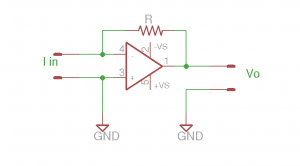
Where the output voltage is determined by the following equation in an ideal situation.
\[V_o = -I_{in} R\]
For the above relationship to hold true, the Op-amp used must have a very small input offset voltage and negligible input bias current. These requirements are especially true when the measurement is down to the pico-amp range as even the minute bias current will affect the accuracy of the measurement. Alan showed an example of using LMC662 to build a picoammeter which is capable of measuring extreme low current. Judging from its datasheet, LMC662 seems to be a good choice for this type of measurement as its input bias current is extremely low, coming just at 2 femto-amp.
The Op-amp I used in my current adapter, Touch Stone TS1001 might be a rather surprising choice for many people. After all, given its relatively mediocre performance data (e.g. 0.5mV input offset voltage, 74dB CMRR and PSRR, 4kHz GBWP) TS1001 looks rather unsuitable for using in such precision instrument. But what makes TS1001 very attractive is that it is a low power Op-amp. It can be operated at a voltage as low as 0.8V and draws as little as 0.8 uA. This makes it very attractive for battery powered operations. In fact, given such low current draw we can even do without an on/off switch!
TS1001 also has a relatively low input bias current (typically at 25 pA). This is more than enough for low current measurement in the nano-amp range. TS1001 does have a relatively large input offset voltage, but this can be easily cancelled out during measurement using the zeroing or relative functions available on most multimeters. Since the offset voltage remains constant during measurements duration, the accuracy of the measurement does not suffer as long as the offset is zeroed out prior to performing measurements.
The schematic below shows the feedback ammeter built around the TS1001. With the component values chosen, the four ranges provide a resolution between 1mA/V and 1uA/V. With a 3 1/2 multimeter, you can easily measure current accurately well down into the nA range. As I mentioned earlier, the input bias current of TS1001 is 25 pA, so I deliberately limited the lowest current range to 1uA/V.
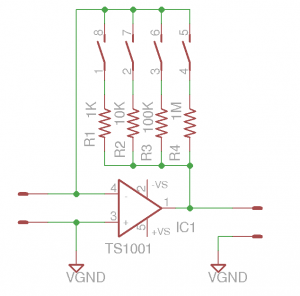
The circuit above can be powered with a single power supply or a split-rail power supply. When powered with a single rail, the input current must flow into the positive input in order to generate an output voltage. So this configuration is most suited for DC current measurement when the current polarity can be predetermined. Using the virtual ground circuit below, this current adapter can be used to measure AC current or DC current of either polarities. In either power supply scenario, TS1001 can be powered from just a single 1.5 battery.
Since TS1001 has a relatively low GBWP, the split-rail configuration is probably only suited at measuring low frequency (e.g. 60Hz) signals. Also, keep in mind that since the maximum output voltage can not exceed the supply power rail, using a split power rail effectively halved the measurement range in either positive or negative range for the same supply voltage.
The precision of the resistors used determines the overall precision of the current adapter. I hand-matched the current range selection resistors to be within 0.1% tolerance. Low temperature coefficient resistors are also desired.
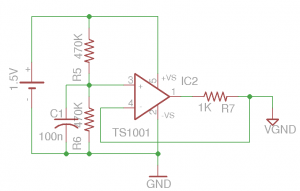
Here is a picture of my finished build. Since I only need to measure low DC current, the virtual ground circuit is not used. As mentioned before, the power consumption of TS1001 is extremely low and thus no power switch is needed. A single AA battery can power the circuit for years. The low power consumption feature makes this adapter very convenient to use.
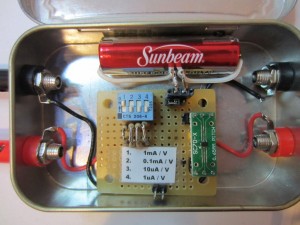
The entire circuit fits into a tin can rather nicely.
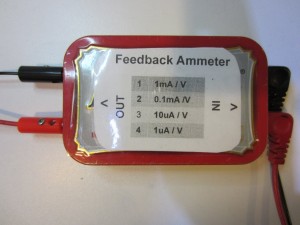
As long as you understand the limitations of TS1001, this circuit performs reasonably well. I may put together another post in the near future to show you the real world performance. If even lower current measurement or measurement of higher frequency signal is required, you will need to choose a more capable Op-amp. AD8603 for instance, is pin compatible with TS1001 and can be used if pico-amp range measurement is needed. With AD8603 however, you will need to increase the supply voltage and add an on/off switch as it is not a low power consumption device.

